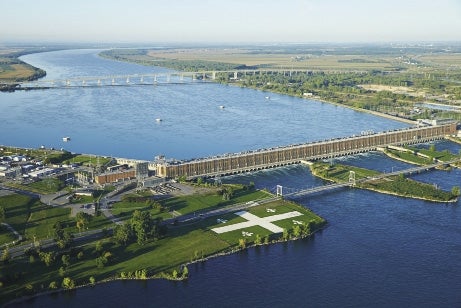Proposals would bring hydropower to Mass.
 Proposals were due at noon Thursday for clean energy generation not derived from offshore wind, the latest milestone towards fulfilling the requirements of an energy law passed last summer.
Proposals were due at noon Thursday for clean energy generation not derived from offshore wind, the latest milestone towards fulfilling the requirements of an energy law passed last summer.
The company developing an electrical transmission line that could carry hydroelectric power from Quebec into New England is among the submissions for long-term clean energy contracts in Massachusetts.
Proposals were due at noon Thursday for clean energy generation not derived from offshore wind, the latest milestone towards fulfilling the requirements of a 2016 energy law that requires Massachusetts utilities to procure 1,600 megawatts of offshore wind and 1,200 megawatts of new hydropower, solar and land-based wind by 2027.
TDI-New England, which is behind the 1,000-megawatt 154-mile project dubbed New England Clean Power Link, submitted two proposals in partnership with Hydro-Quebec, Gaz Metro and Boralex that the company says would deliver roughly $20 billion in benefits to Massachusetts over 20 years.
The first proposal would provide 1,000 megawatts of hydropower sourced from the existing Hydro-Quebec system and transmitted from Canada via the NECPL. The second proposal calls for 700 megawatts of power from the Hydro-Quebec system and an additional 300 megawatts sourced from a new wind farm that Gaz Metro and Boralex plan to construct, also delivered along the NECPL.
The company said both of its proposals present "the best and most cost-effective opportunity for the Commonwealth to meet its climate change goals."
"Blackstone is proud to partner with the State of Vermont, Hydro Québec, Gaz Métro and Boralex to assist Massachusetts in achieving its targeted reduction in greenhouse gases under the Global Warming Solutions Act," Sean Klimczak, senior managing director of Blackstone, which manages TDI-New England, said in a statement. "The New England Clean Power Link is a transformative smart grid project that will meaningfully reduce power prices and greenhouse gases in the State of Massachusetts for many future generations."
TDI-New England said the benefits of their proposals would include $16 billion in energy, capacity and natural gas savings over 20 years, and $4 billion in economic and environmental benefits over 20 years. The NECPL is expected to cut carbon dioxide emissions in Massachusetts and New England by nearly three million tons per year, TDI-New England said.
The NECPL project consists of 154 miles of buried transmission line, entering the United States under Lake Champlain and traversing 97 miles under the lake. The 57-mile stretch that will be buried underground would extend from Benson to Ludlow, Vermont. The transmission lines will not be visible at any point of the route, according to TDI-New England. Existing infrastructure would supply the power from Ludlow, Vermont, into Massachusetts.
"The best part of the New England Clean Power Link project? Your good neighbors to the north, Vermont, want it, support it and will also benefit from it," a narrator reads in a roughly seven-minute video touting the virtues of the NECPL that also featured support from Vermont Gov. Phil Scott and former Massachusetts energy secretary Ian Bowles.
National Grid and Citizens Energy also submitted proposals for two projects -- Granite State Power Link (GSPL) and Northeast Renewable Link (NRL) -- to deliver "land-based wind power and solar generation already under development from Canada and New York" to Massachusetts to reduce carbon emissions by approximately three million tons annually.
"With the retirement of much of the region's fossil fuel generating plants, Massachusetts customers need a ready path to clean, reliable, diverse power. GSPL and NRL will enable the Commonwealth to meet its environmental goals by bringing large-scale, renewable energy to customers for years to come," John Flynn, senior vice president of US strategy and business development for National Grid, said in a statement.
The GSPL project would consist of 59 miles of new transmission line from a new converter station in northern Vermont to a new converter station in Monroe, New Hampshire. Also, 109 miles of existing transmission lines would need to be upgraded.
The GSPL project would be capable of carrying 1,200 megawatts of new wind power from Quebec that is currently in development, project organizers said, and developers expect it would lead to a $2.8 billion reduction in energy and capacity market costs in Massachusetts.
The request for proposals (RFP) issued in March by the Department of Energy Resources calls for distribution companies and bidders to enter "cost-effective long-term contracts" by 2022 and encourages projects that can "commit to begin deliveries prior to the end of 2020 to maximize the Commonwealth's ability to meet its Global Warming Solution Act."
The GWSA set legal requirements that the state must meet in reducing greenhouse gas emissions. The law requires emissions by 2020 that are 25 percent lower than 1990 levels, and by 2050 emissions that are 80 percent below 1990 levels. In 2014, emissions were 21 percent below 1990 levels, according to the state Department of Environmental Protection.
Also Thursday, Central Maine Power and its parent company Avangrid submitted a plan offering "several proposals for transmission line investments," proposing to deliver up to 1,200 megawatts of hydroelectric and wind power from Quebec to Massachusetts.
The timeline laid out in the RFP calls for projects to be selected for negotiation by Jan. 25, 2018, with contracts submitted for Department of Public Utilities approval by April 25.









0 Comments